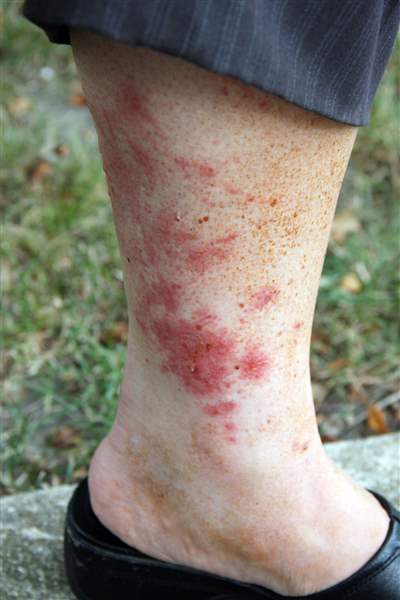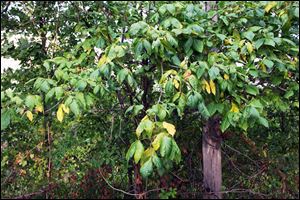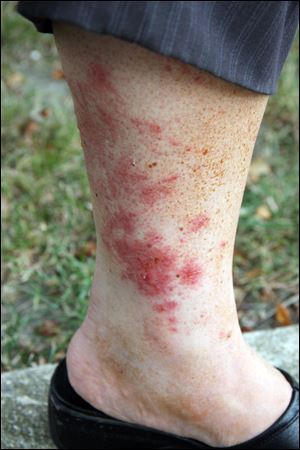
Poison ivy not to be forgotten or underestimated
Plant a problem for anything it touches
7/30/2012
Poison ivy can leave sufferers with rashes such as this.
THE BLADE/DAVID PATCH
Buy This Image

Poison ivy is a noxious plant that for many people causes an itchy rash soon after contact, sometimes severe enough to require hospitalization. And anyone unfortunate enough to breathe smoke from burning poison ivy may suffer potentially fatal respiratory-tract damage.
Leaves of three, let it be.
So goes the classic advice about poison ivy, the noxious plant that for many people causes an itchy rash soon after contact, sometimes severe enough to require hospitalization. And anyone unfortunate enough to breathe smoke from burning poison ivy may suffer potentially fatal respiratory-tract damage.
But how can you "let it be" if you don't know it's there?
FACTS ABOUT POISON IVY
Avoid touching the plant, and when entering areas where poison ivy may grow, cover up! Wear closed shoes, socks, long-sleeved pants and shirts, and gloves.
If exposed, wash skin with soap and COLD water, or rubbing alcohol. You typically have about 10 minutes before oil sets into the skin and causes a rash. Scrub thoroughly, including under fingernails; poison ivy can be spread by oil on fingers.
If a pet has touched poison ivy, bathe the animal with pet shampoo and water while wearing rubber gloves.
Also wash gardening tools or any other item that may have contacted poison ivy. Oil can rub onto objects and remain potent for years.
If you develop a poison ivy rash, use a cold compress, calamine lotion, an over-the-counter hydrocortisone cream, or antihistamine to relieve itching. Folk remedies include banana peel, anti-perspirant, and cucumber.
See a doctor if the rash is near the eyes, other sensitive body areas, or covers a large part of the body.
Get immediate medical attention if you believe you have inhaled smoke from burning poison ivy.
While poison ivy can be transferred via its oil, it is not contagious from the rash, blisters, or bodily fluid.
(Source: WebMD; Poison Ivy, Oak & Sumac Information Center)
Poison ivy isn't just hazardous; to the degree a plant can be so described, it's sneaky and can be spread as simply as through a bird dropping; birds eat the tiny berries that grow on mature poison ivy vines and deposit the seeds elsewhere. Poison ivy also spreads by sending runners along or just beneath the surface.
PHOTO GALLERY: Beware of poison ivy
Poison ivy is a climber, too, and it can reach out at chest-eye level from the trunk of a small tree.
Climb, oh, how poison ivy loves to climb! While it grows also as a ground cover or in free-standing, bushy form, some of the most expansive poison ivy -- and also the most dangerous to unsuspecting passers-by -- grows from vines running up tree trunks, walls, fences, and utility poles.
It is common throughout the eastern two-thirds of North America, and its cousin, poison oak, is found all over the Intermountain West and Pacific Coast.
The leaves of three sprawl from a lilac bush at Angola Road and Acton Drive in South Toledo. A quick glance downward leads to a poison-ivy carpet ringing the shrub's base, its leaves' varying sizes and colors a testament to how diverse its appearance can be.
Poison ivy leaves sprout with a shiny, scarlet tinge in the spring and at the leading edge of new growth. Mature leaves tend to be a darker green -- sometimes shiny, sometimes not -- and can grow to be quite large on the largest, most vigorous vines.
In autumn, poison ivy can become terrifyingly beautiful, its leaves turning to a riot of bright yellows, oranges, and reds, with the entire spectrum sometimes evident on the same vine.
Gary Keys, a spokesman for Toledo Edison, said that while most of the utility's line maintenance is done using bucket trucks, linemen and other field workers are taught to look out for poison ivy climbing poles and instructed to wash their tools, equipment, and clothing afterward.

Poison ivy can leave sufferers with rashes such as this.
"We do a safety focus at the beginning of the year, in springtime," Mr. Keys said. "We school 'em pretty good."
But poison ivy's toxin, an oil called urushiol, is there year-round, not just during green season. It also is potent in the vine's branches, stems, and roots -- even long after they have been cut. Urushiol also can travel on shoes, clothing, and the fur of animals that have brushed against poison ivy leaves or stalks.
So to avoid poison ivy's itchy rash and blistering, it's not enough to remember the "leaves of three" advice. Be vigilant, too.
It's wise to take a careful look around in flower beds every so often for unfamiliar plants -- especially in spring, when budding poison ivy's scarlet leaves distinguish it, and in fall, when its autumnal color is likely to contrast with its surroundings.
Check bushes, shrubs, and ground covers for any leaves that don't match. On tree trunks, poison ivy vines stand out as being gnarly and very "hairy" with numerous tiny tendrils attaching the vine to the tree, and often small shoots of vine grow out from the main stem.
Be careful working in the yard when wearing open shoes or shorts, or otherwise exposing skin to potential contact with unfriendly foliage.
And unless you're one of the lucky ones who isn't allergic to urushiol, wear rubber gloves to yank poison ivy out of the ground. Herbicides may also work, but at the risk of killing nearby desirable plants, and my experience has been that poison ivy roots are remarkably hardy, even against products like Roundup.
Promptly wash gloves and clothing worn while handling poison ivy.
In parks, at the beach, or in other outdoor public places, pay special attention to fencelines, riverbanks, roadsides, and other "edge" places. Poison ivy is often found in places disturbed by people, including the fringes of farm fields. Be especially wary of low-hanging "tree branches" that don't look the same as the rest of the tree, especially if the tell-tale hairy vine is growing up the trunk.
Of course, not every plant with three-leaf clusters is poison ivy. Box elder is one of several plants commonly mistaken for the itch-inducing weed, and common green beans even bear a strong resemblance. Virginia creeper, another impostor, is actually easy to distinguish because its leaves cluster in fives, not threes.
Contact David Patch at: dpatch@theblade.com or 419-724-6094.